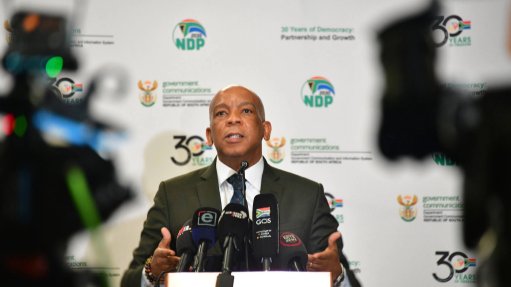Large storage batteries
Before cellphones, the only rechargeable batteries were NiCad batteries, and they were not terribly good.
There was a drive to come up with something better, and so the lithium-ion battery was invented. It is a good technology and the charge and discharge cycles are quite efficient. A similar drive is now on the horizon: various organisations are suggesting that South Africa should have a 100% renewable electricity system by 2050. This is according to a study by Finland’s LUT University – as to why that university, I have no idea.
The study suggests that, in South Africa, we should have photovoltaic (PV) and wind energy supplying 71% and 28% respectively of electricity demand. The remaining 4% will be supplied by coal and gas turbines. Currently, PV in South Africa is about 3 500 MW and wind about 900 MW, or about 10% and 2.5% respectively.
Now, something that is often forgotten is that, on a windless night, there is no or very little power generation. There is a school of thought that says, somewhere, the wind is always blowing, but it ain’t so. For example, right now in Cape Town, the maximum wind is about 13 m/s, which is marginal for a wind turbine. So, where does the power come from on a windless night? Here we are looking for something to supply 68% of the connected load, if we assume the wind, coal plants and gas turbines will, in fact, be generating but the PV not. In today’s terms, we would need 68% of 35 000 MW, or about 14 000 MW, for at least 12 hours; in other words, 168 000 MWh.
This will have to come from a storage source – in this case, a very large lithium-ion battery or batteries. The largest lithium-ion battery right now is a Tesla battery in Australia, rated at 129 MWh. We will need a lot of backup batteries in South Africa if PV and wind supply most of the power. The specific energy of a lithium-ion battery is 260 Wh/kg. Thus, if we assume the battery backup is going to be 168 000 MWh contained in 1 000 units in different locations, we will have each unit delivering 168 MWh and having a mass of 650 t. This is about four times the weight of a wind turbine and tower. When we talk of batteries, we should recall that they store direct current, and alternating current is what has to be supplied to the grid. The world’s biggest inverter (which changes direct current to alternating current) is rated at about 4 000 MW. Thus, we could have 20 of the 168 MWh units connected and we would need 50 such installations.
So: 1 000 battery units, 50 invertors, installation and connection. Given that a Tesla battery costs about $400/kWh installed, we will need $67-billion plus some change for the inverters. I will avoid making any remarks about cost increases attributable to fraud and collusion.
The sum of $67-billion is a significant chunk of the South African Budget, and this is just for backup batteries and inverters. If we recall that the PV installation will have to be about double the connected load so that the batteries can be charged up while the load is being supplied, we will need a PV installation of about 25 000 MW. This is also going to cost a lot of money, estimated at $50-billion. This is the other chunk of the South African Budget.
No disrespect to LUT University, but did its researchers actually think this thing through? We are currently burdened by State-owned enterprises such as Eskom, South African Airways and the South African Broadcasting Corporation . . . does this country really want to be burdened by the costs of PV and wind power and batteries, as suggested? However the finance works, nobody is going to install all this kit for free. This is a simple stark fact. It may be a great green idea, but it costs too much. We cannot afford it. Way too expensive.
Article Enquiry
Email Article
Save Article
Feedback
To advertise email advertising@creamermedia.co.za or click here
Comments
Press Office
Announcements
What's On
Subscribe to improve your user experience...
Option 1 (equivalent of R125 a month):
Receive a weekly copy of Creamer Media's Engineering News & Mining Weekly magazine
(print copy for those in South Africa and e-magazine for those outside of South Africa)
Receive daily email newsletters
Access to full search results
Access archive of magazine back copies
Access to Projects in Progress
Access to ONE Research Report of your choice in PDF format
Option 2 (equivalent of R375 a month):
All benefits from Option 1
PLUS
Access to Creamer Media's Research Channel Africa for ALL Research Reports, in PDF format, on various industrial and mining sectors
including Electricity; Water; Energy Transition; Hydrogen; Roads, Rail and Ports; Coal; Gold; Platinum; Battery Metals; etc.
Already a subscriber?
Forgotten your password?
Receive weekly copy of Creamer Media's Engineering News & Mining Weekly magazine (print copy for those in South Africa and e-magazine for those outside of South Africa)
➕
Recieve daily email newsletters
➕
Access to full search results
➕
Access archive of magazine back copies
➕
Access to Projects in Progress
➕
Access to ONE Research Report of your choice in PDF format
RESEARCH CHANNEL AFRICA
R4500 (equivalent of R375 a month)
SUBSCRIBEAll benefits from Option 1
➕
Access to Creamer Media's Research Channel Africa for ALL Research Reports on various industrial and mining sectors, in PDF format, including on:
Electricity
➕
Water
➕
Energy Transition
➕
Hydrogen
➕
Roads, Rail and Ports
➕
Coal
➕
Gold
➕
Platinum
➕
Battery Metals
➕
etc.
Receive all benefits from Option 1 or Option 2 delivered to numerous people at your company
➕
Multiple User names and Passwords for simultaneous log-ins
➕
Intranet integration access to all in your organisation


















